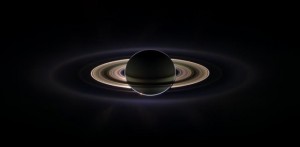Saucy Saturn Shows Off at Air And Space Museum
/https://tf-cmsv2-smithsonianmag-media.s3.amazonaws.com/filer/best_saturn_portrait.jpg)
We may like Saturn because it's got a ring on it, but there's more to the sixth planet in our solar system than its saucy shape. New images taken by the Cassini and Huygens spacecrafts, which have been zipping around Saturn since 2004, are revolutionizing the way we think about the gas giant and its moons.
For example, with the data rolling in from Cassini, we're learning that storms in Saturn's atmosphere may be just as intense as Jupiter's red spot. The spacecraft is also contributing to a second look at how Saturn's rings evolved. Have they been around since the planet's beginning or did they form later? Scientists will need some more information before they can answer that for sure, but they have time. Cassini will be snapping pictures of Saturn for at least another year and a half.
However, the recently opened exhibit, "Spectacular Saturn: Images from the Cassini-Huygens Mission," doesn't focus on the science. The exhibition of more than 60 views of the Saturn system at the Smithsonian's National Air and Space Museum through Dec. 25, is really an art gallery.
"This is not an exhibit set up as a lecture from a planetary 101 course," says John Grant, head of Air and Space's Center for Earth and Planetary Studies. "The information is there. But when you walk in and see these images, it tells you something about the beauty of our solar system."
For example, the picture to the right depicts the giant Saturn hanging in the blackness and sheltering Cassini from the sun's blinding glare. The spacecraft viewed the rings as never before, revealing previously unknown faint rings and even glimpsing Earth. It combines a total of 165 images taken by the Cassini wide-angle camera over nearly three hours on Sept. 15, 2006.
Included among the images are glimpses of Saturn's moon Titan, found to have rivers of liquid methane, as well as the moon Enceladus, where water ice geysers were found bursting from its south pole. Saturn's dynamic system may quickly give the other 3 gas giants a run for their money.
For the official source of Cassini images of Saturn, its rings and moons, check out the CICLOPS Website.
/https://tf-cmsv2-smithsonianmag-media.s3.amazonaws.com/accounts/headshot/joseph-caputo-240.jpg)

/https://tf-cmsv2-smithsonianmag-media.s3.amazonaws.com/accounts/headshot/joseph-caputo-240.jpg)